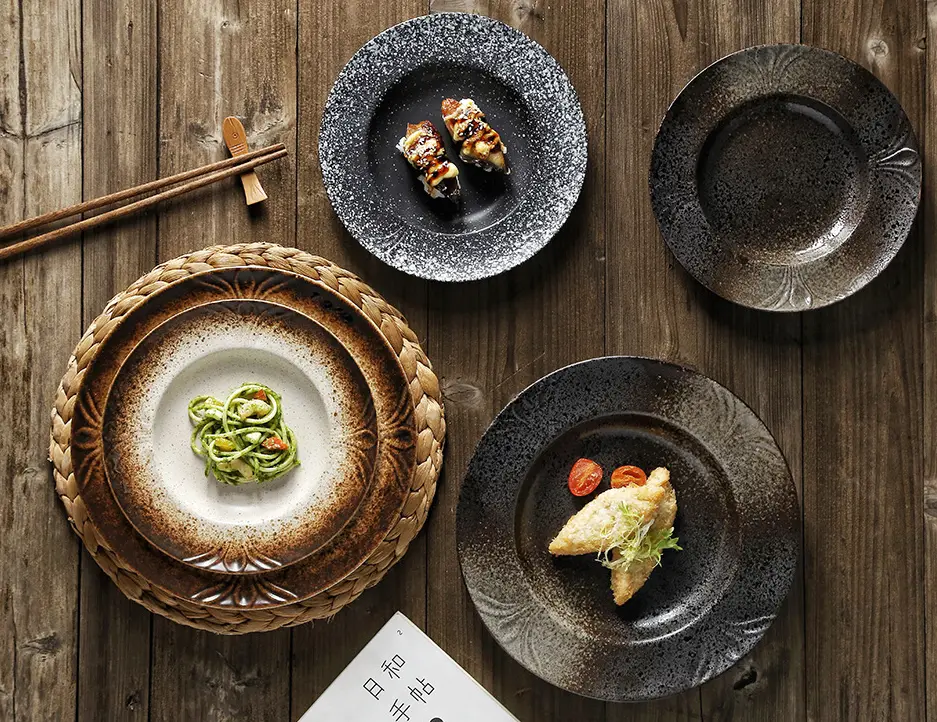We need to use tableware to serve our food every day, and ceramic plates are the most closely related. I think many people, like me, are concerned about whether ceramic plates will have an impact on our health and whether daily use is safe. The following is an article compiled by Myoung Ceramics based on scientific facts and industry standards, covering health, heat resistance, quality assessment, and Chinese ceramic characteristics. All data comes from authoritative institutional standards and scientific research literature:
1.Is it healthy to eat in ceramic plates?
*Core conclusion: Ceramic discs that meet national standards are safe, but caution should be taken against inferior glazed products. We need to pay attention to the safety of the materials.
Generally speaking, ceramic bodies (clay+minerals) form stable silicate structures after high-temperature sintering above 1200 ℃, with non-toxic release. The key risk points are in the glaze and decorative layer:
(1) Underglaze color:
The pigment solidifies at high temperatures under the glaze layer, and the leaching of lead and cadmium approaches zero (in accordance with GB 4806.4-2016 “National Food Safety Standard for Ceramic Products”).
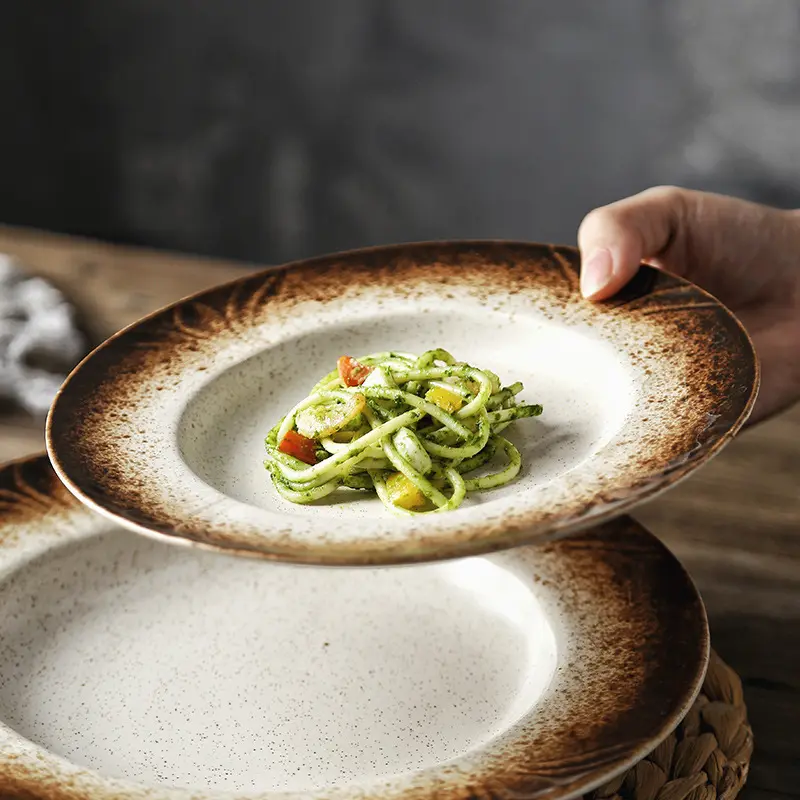
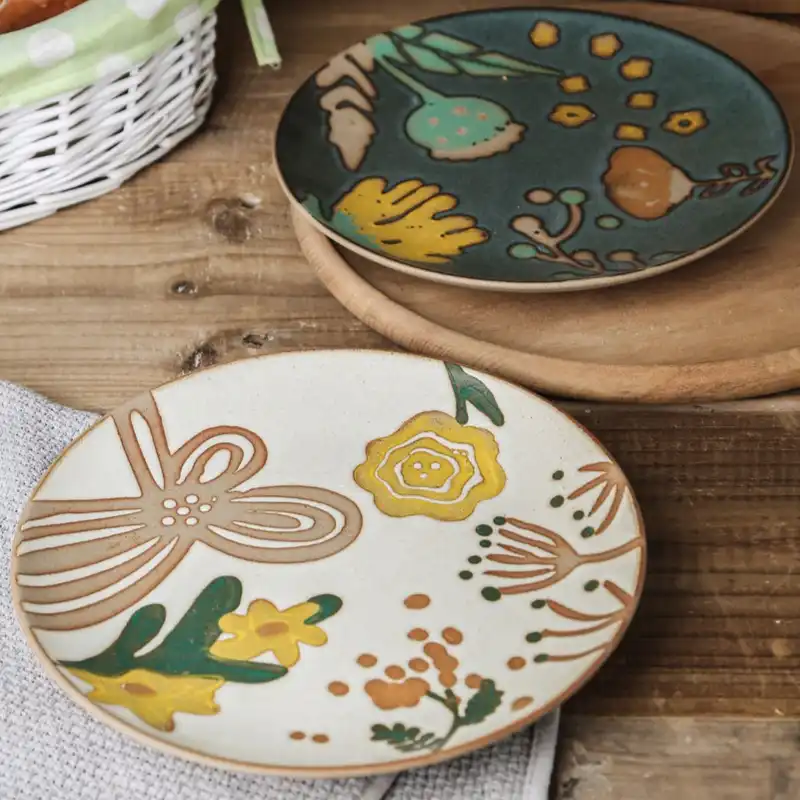
Source:Wholesale Ceramic Dinnerware Supplier-Myoung
(2) Glazed color:
Pigments adhere to the glaze surface. If cheap pigments containing lead and cadmium are used, acidic foods may dissolve heavy metals (measured data: Poor quality glazed color discs can dissolve lead up to 5mg/L after being soaked in vinegar for 2 hours, exceeding the national standard by 10 times).
At this point, we need to refer to relevant authoritative standards, such as the Chinese standard limit value (GB 4806.4) for testing items and the international standard (ISO 6486) which states: lead leaching amount (mg/L) ≤ 0.5 ≤ 0.8; Cadmium leaching amount (mg/L) ≤ 0.25 ≤ 0.07
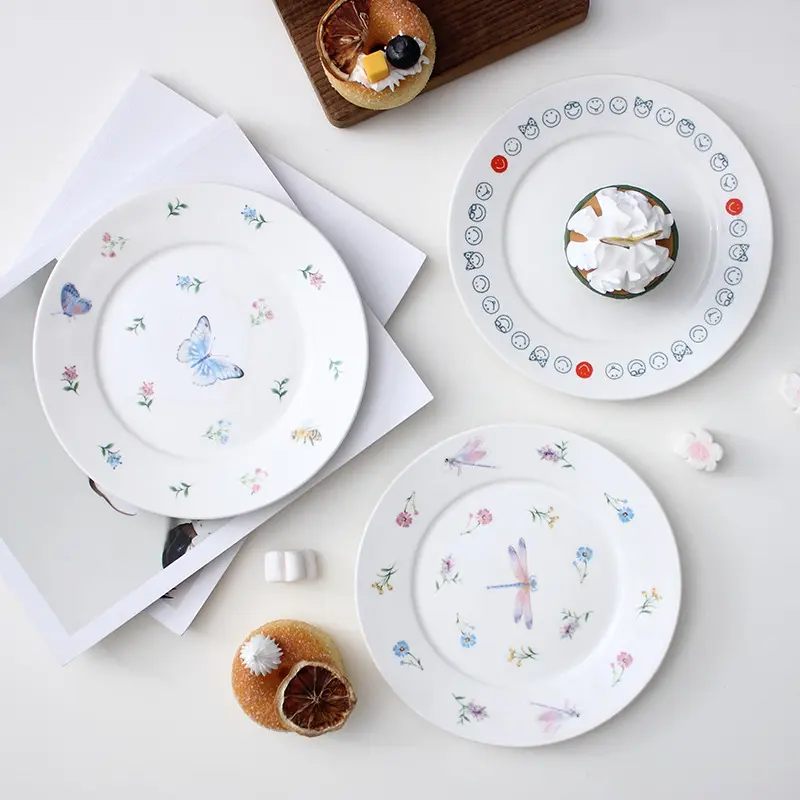
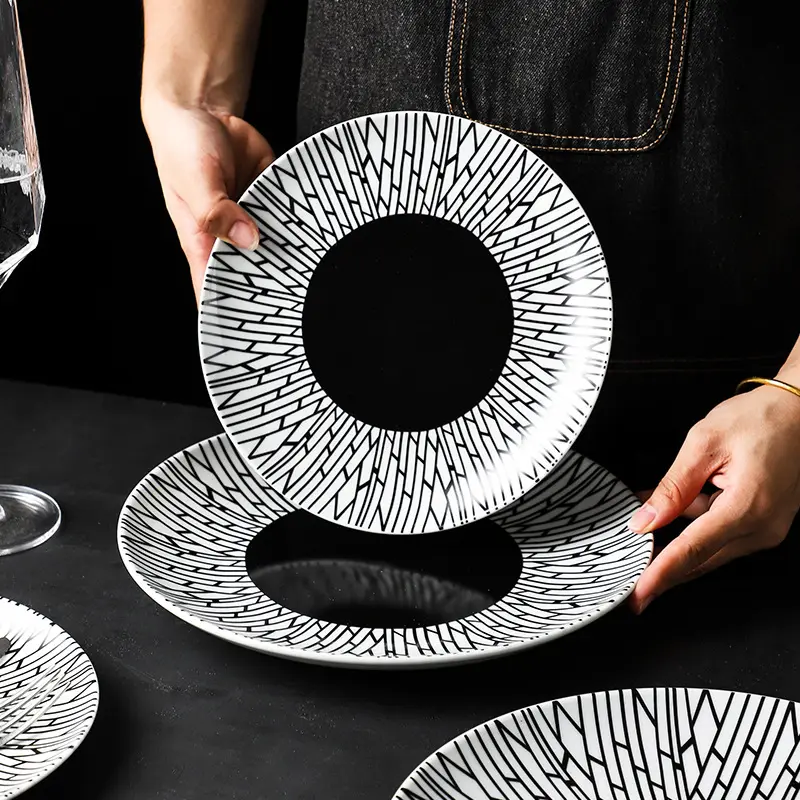
Myoung Ceramics recommends purchasing ceramic plates for businesses and consumers: prioritize choosing “underglaze color” or unpainted white porcelain (Chaozhou underglaze color process without lead chromium and other metals; Jingdezhen white porcelain has a lead cadmium detection rate of 0%).
Avoid storing acidic foods (such as tomatoes, lemons, vinegar) on glazed trays.
2.Can ceramic plates break from heat?
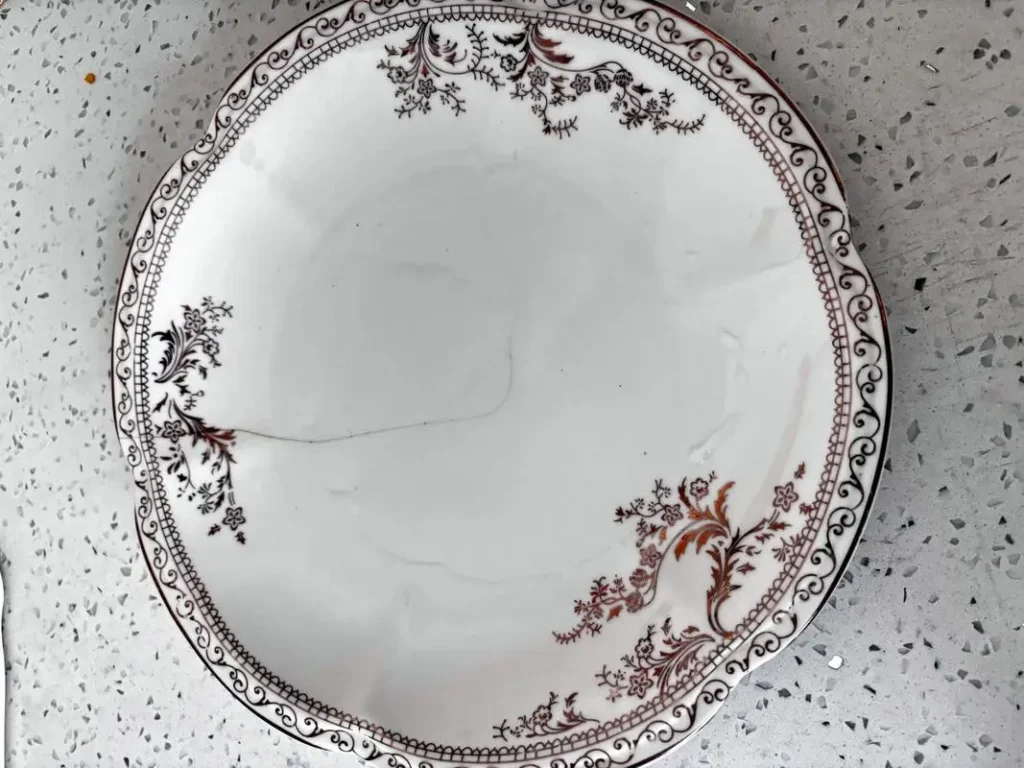
*Core conclusion: High quality ceramics are resistant to high temperatures, but they are afraid of sudden temperature differences (thermal shock).
Heat resistance data: We can judge from the sintering temperature: porcelain ≥ 1280 ℃, stoneware 1200-1250 ℃. The upper limit of the temperature for daily household ceramic tableware usage is: it can withstand an oven temperature of 250 ℃ (such as IKEA 365+series) and open flame direct firing temperature of 800 ℃ (special heat-resistant ceramics). Why does a ceramic disc break after being fired at over a thousand degrees Celsius? The main reason is that the mismatch in thermal expansion coefficient leads to stress cracking.
Myoung Ceramics has compiled experimental data on the critical temperature difference for fracture – typical scenarios of ceramic type thermal shock temperature difference (℃) risk:
(1) Bone china 80-100 hot plate directly flushed with cold water → ruptured
(2) Reinforced porcelain 120-150 oven, remove and place damp cloth → low-risk
(3) Heat resistant stoneware 200+open flame baking → safe (such as ceramic plates produced in Chaozhou, Guangdong)
*Crack prevention guide:
(1) Prohibition: Hot plate rapid cooling (soaking in cold water, placing on a metal table).
(2) Allow: enter the oven (confirm no metal decoration), microwave heating (even glaze without gold edges).
3.Is the quality of ceramic plates good?
*Core conclusion: Strength and lifespan depend on raw materials and processes, and high-quality porcelain plates can be used for decades.
Quality Core Indicators: Low end Ceramic Plate, Standard Porcelain, High end Bone Porcelain
Parameters: Water absorption rate (ISO 10545-3)>5% (easy color bleeding) ≤ 0.5% ≤ 0.3%
Bending strength (MPa) 30~40 60~80 90~110; Mohs hardness level 5~6 level 7 (wear-resistant) level 7.5
Perhaps the data here is too digitized and not suitable for us to remember and compare in our daily lives. Myoung Ceramics has provided a brief summary of the risk points of inferior products for businesses and consumers:
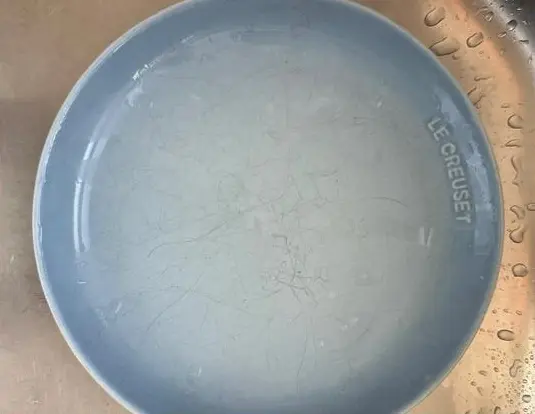
(1) Cracking: Mismatched coefficient of expansion of the glaze (commonly seen in low-temperature fast firing products).
(2) Scratches on Glazed Surface: Low hardness glazes (<level 6) are prone to scratching and bacterial growth from metal tableware.
(3) Heavy metal leaching: Cheap enamel pigments do not meet national standards.
Selection tips: (1) Listening: Gently tap the edge, crisp metallic sound → high-density porcelain, muffled sound → low-temperature pottery. (2) Transparency: Bone china has a transparency of over 30% (turning red under light). (3) Bottom view: The foot circle is flat without glaze or thorns, and it is a sign of fine firing technology.
4. Are Chinese plates made of ceramics?
*Core conclusion: China is the birthplace of ceramics, with ceramics accounting for over 80% of modern tableware
China’s ceramic industry data:
(1) Production: 75% of the world’s daily-use ceramics are produced in China, with Chaozhou Ceramic Dinnerware Set Wholesale Market accounting for about 30% of the market share. (2023 Young Industry Federation data).
(2) Material distribution: Reinforced porcelain (aluminum magnesium): accounting for 60% (Zibo, , Chaozhou, Tangshan); Bone china: accounting for 25% (Tangshan, Chaozhou, bone powder content ≥ 40%); Traditional white porcelain: accounting for 15% (Jingdezhen, Dehua).
(3) Regional Characteristics and Technological Advantages – International Certification of Origin Core Material Characteristics:
–Chaozhou: Magnesium reinforced porcelain and synthetic bone porcelain, with a strength of 120MPa, thermal stability of 180 → 20 ℃ without cracking, transparency>45%, whiteness>95%, FDA certification (USA), EU food contact material regulations (especially 84/500/EEC lead and cadmium limits), EU LFGB certification, and ISO 9001 quality management system certification.
–Jingdezhen: Kaolin porcelain has a whiteness of over 85%, a warm glaze, and is certified by the European Union’s LFGB.
–Dehua: The transparency of “Chinese white” jade porcelain is greater than 40%, the tire is as thin as paper, and it has FDA food grade certification.
–Tangshan: Synthetic bone china with a strength of 120MPa, microwave safe, according to the standards of the British Bone Porcelain Association.
*Consumer tip:
(1) Beware of false labeling: if it is not produced in Jingdezhen, it will be labeled as “Jingdezhen made” (the genuine product will be stamped with seal script).
(2) Identify the origin code: for example, “Yue U · DB”=Guangdong Chaozhou High end White Porcelain (GB/T 13522-2008).
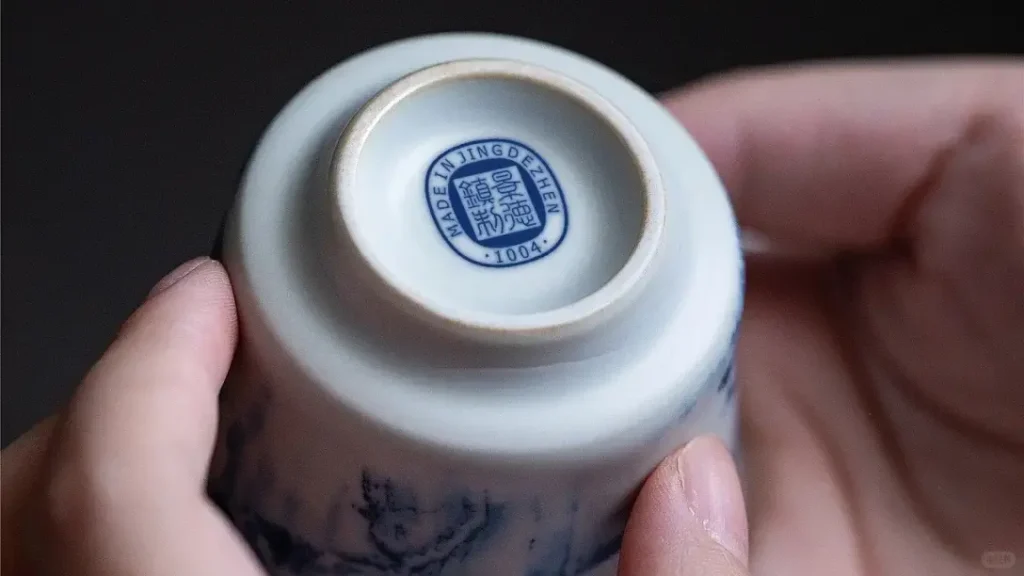
5.Ultimate usage advice for choosing ceramic plate
(1) Health first choice: Uncolored underglaze porcelain (recommended Chaozhou reinforced porcelain, Jingdezhen white porcelain, Dehua jade porcelain).
(2) Durable choice: Heat shock resistant reinforced porcelain (suitable for ovens, with high cost-effectiveness produced in Chaozhou and Zibo).
(3) Guide to avoiding pitfalls: Glazed color plates are only used as cold/fruit plates. Remove the metal edge plate before microwave heating. Regarding the above three suggestions, Myoung Ceramics, a Chaozhou ceramic tableware wholesaler, mainly in ceramic plates wholesale,can achieve them. For more detailed information, please click:
Or you want to know more about the top daily porcelain supplier in China:

